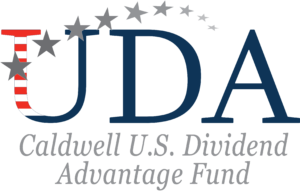December 2022 Recap
For the month of December, the Caldwell U.S. Dividend Advantage Fund (“UDA” or “Fund”) declined -4.1% versus a decline of -5.8% for the S&P 500 Total Return Index (“Index”). At the sector level, top performers were Utilities, Healthcare, and Consumer Staples, whereas Consumer Discretionary, Information Technology, and Communication Services were relative underperformers. November’s market rally, sparked by a lower-than-expected inflation print, proved to be short-lived as equities continued to sell off in December on recessionary concerns.
From an attribution standpoint, December was a challenging month in which every sector in the Index declined. Aside from cash holdings, the Fund’s performance was aided by Northrop Grumman (“NOC”, +2.3%), Broadcom (“AVGO”, +2.2%), and Cigna (“CI”, +1.0%). NOC performed well in the face of a broader market decline as investors remain comfortable with the counter-cyclical and recession-resistant characteristics of its business. Investors were pleased with AVGO after the company provided strong guidance and disclosed that it is fully booked for the year ahead, continuing to execute better than its peers. CI held up well in a declining market as our thesis for the company remained intact.
Full-Year 2022 Recap
The year 2022 proved to be yet another strong year for the Fund. The Fund declined -5.0% for the full year, vastly outperforming the Index’s -12.2% decline.
The market had a tough act to follow in 2022 after the stellar returns generated by the Index in 2021. The year 2021 ended strongly with the post-COVID economic recovery gaining momentum and supply chain issues easing, which had led the market to all-time highs. However, after an eventful and volatile year, investors were ultimately left disappointed as 2022 delivered the worst performance of any single year since the catastrophic declines of 2008 during the Global Financial Crisis. The decline in the market was underpinned by macroeconomic uncertainty, geopolitical instability, and the Federal Reserve taking a sharp hawkish stance following over a decade of dovishness in a resolute move to cool persistently high inflation. These factors coupled together rationalize the increased volatility and the underlying weakness experienced in the market throughout the year.
Energy was by far the strongest-performing sector in 2022 as a result of elevated energy prices, which were a direct consequence of the energy crisis inflicted by Russia’s invasion of Ukraine. Utilities and Consumer Staples also posted small positive returns for the year as investors took more defensive positioning in anticipation of a potential recession. In contrast to their performance in 2021, high-growth, richly valued sectors were most negatively impacted by rapidly rising rates and posted the worst returns. Among these were Communication Services, Consumer Discretionary, and Information Technology.
While we remain mindful of the macro environment, the Fund employs a bottom-up investment approach designed to seek out attractive investment opportunities in any market. Over the long run, given its unique momentum-driven investment approach and focus on well-managed, dividend growth companies, we believe UDA is well-positioned to provide strong performance by way of both attractive regular monthly distributions and long-term capital appreciation potential. We expect that our approach to dividend growth investing should continue to provide a means of generating compelling risk-adjusted returns for our investors over the long term.
1All returns (for the fund, individual stocks and sectors) are in total return, Canadian dollar terms. All stock returns represent performance for the full period noted. All fund returns are in respect of Series F.
Standard performance as at December 31, 2022:
Caldwell U.S. Dividend Advantage Fund (Series F): 1 Year: -4.6%, 3 year: 8.2%, 5 year: 8.3%, Since Inception (June 19, 2015): 8.6%.
S&P 500 Total Return Index: 1 Year: -12.2%, 3 year: 9.2%, 5 year: 11.2%, Since Inception (June 19, 2015): 11.8%.
2Actual investments, first purchased: NOC 5/9/2022, AVGO 5/9/2022, CI 6/21/2022.
All data is as of December 31, 2022 sourced from Morningstar Direct or S&P Capital IQ, unless otherwise indicated. Fund returns are from FundData. UDA, Index total return numbers, sector returns and individual stocks returns are in CAD terms. The Fund was first offered to the public as a closed-end investment since May 28, 2015. Effective November 15, 2018 the Fund was converted into an open-end mutual fund such that all units held were redesignated as Series F units. Performance prior to the conversion date would have differed had the Fund been subject to the same investment restrictions and practices of the current open-end mutual fund.
The information contained herein provides general information about the Fund at a point in time. Investors are strongly encouraged to consult with a financial advisor and review the Simplified Prospectus and Fund Facts documents carefully prior to making investment decisions about the Fund. Commissions, trailing commissions, management fees and expenses all may be associated with mutual fund investments. Rates of returns, unless otherwise indicated, are the historical annual compounded returns including changes in unit value and reinvestment of all distributions and do not take into account sales, redemption, distribution or optional charges or income taxes payable by any unitholder that would have reduced returns. Mutual funds are not guaranteed; their values change frequently and past performance may not be repeated. The payment of distributions should not be confused with a fund’s performance, rate of return or yield. If distributions paid are greater than the performance of the fund, your original investment will shrink. Distributions paid as a result of capital gains realized by a fund, and income and dividends earned by a fund, are taxable in your hands in the year they are paid. Your adjusted cost base (“ACB”) will be reduced by the amount of any returns of capital and should your ACB fall below zero, you will have to pay capital gains tax on the amount below zero.
Publication date: January 16, 2023.
